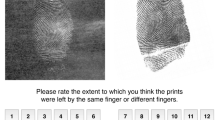Abstract
The challenge of understanding how automated tools might introduce bias has gained a lot of interest. If biases are not interpreted and solved, algorithms might reinforce societal discrimination and injustices. It is also not clear how to measure fairness in algorithms. In biometrics disciplines such as automatic facial recognition, examining images pertaining to male subjects has been proven does not yield the same error rates as when examining images from female subjects. Furthermore, recent studies found that automatic fingerprint match scores vary based on an individual’s age and gender. Although ROC curve has been essential for assessing classification performance, the presence of covariates can affect the discriminatory capacity. It might be advisable to incorporate these covariates in the ROC curve to exploit the additional information that they provide. More importantly, the ROC regression modeling discussed in the paper can handle both continuous covariates such as age and discrete covariates such as gender and race. The resulting adjusted ROC curve provides error rates which account for demographic information pertaining to each subject. Thus, a better measure of the discriminatory capacity is generated compared to the pooled ROC curve.
Access this chapter
Tax calculation will be finalised at checkout
Purchases are for personal use only
Similar content being viewed by others
References
Next generation identification (NGI). https://www.fbi.gov/services/cjis/fingerprints-and-other-biometrics/ngi
Amini, A., Soleimany, A.P., Schwarting, W., Bhatia, S.N., Rus, D.: Uncovering and mitigating algorithmic bias through learned latent structure. In: AAAI/ACM Conference on AI, Ethics, and Society, pp. 289–295 (2019)
Calmon, F., Wei, D., Vinzamuri, B., Ramamurthy, K., Varshney, K.: Optimized pre-processing for discrimination prevention. In: Advances in Neural Information Processing Systems, pp. 3992–4001 (2017)
Cao, K., Nguyen, D., Tymoszek, C., Jain, A.: End-to-end latent fingerprint search. arXiv preprint arXiv:1812.10213 (2018)
Cole, S.A.: More than zero: accounting for error in latent fingerprint identification. J. Crim. Law Criminol. 95, 985 (2004)
Gnanasivam, P., Muttan, D.S.: Estimation of age through fingerprints using wavelet transform and singular value decomposition. Int. J. Biometr. Bioinform. (IJBB) 6(2), 58–67 (2012)
Hornak, L., et al.: FBI biometric collection of people (BioCoP): next generation identification phase 1 (2008–2009). In: 2008 Biometric Collection Project 08–06-2008 to 12–31-2009 FINAL REPORT (2009)
Hutchinson, B., Mitchell, M.: 50 Years of Test (un) fairness: lessons for machine learning. In: Proceedings of the Conference on Fairness, Accountability, and Transparency, pp. 49–58 (2019)
Huynh, C., Brunelle, E., HalaÌmkovaÌ, L., Agudelo, J., HalaÌmek, J.: Forensic identification of gender from fingerprints. Anal. Chem. 87(22), 11531–11536 (2015)
Jain, A.K., Ross, A., Prabhakar, S.: An introduction to biometric recognition. IEEE Trans. Circuits Syst. Video Technol. 14(1), 4–20 (2004)
Lu, Y., Guo, H., Feldkamp, L.: Robust neural learning from unbalanced data samples. In: International Joint Conference on Neural Networks, vol. 3, pp. 1816–1821 (1998)
Marasco, E., Lugini, L., Cukic, B.: Exploiting quality and texture features to estimate age and gender from fingerprints. In: SPIE Defense and Security (2014)
Marasco, E.: Biases in fingerprint recognition systems: where are we at? In: IEEE Biometrics: Theory, Applications and Systems - Special Session on Generalizability and Adaptability in Biometrics (BTAS-SS GAPinB)
Marasco, E., Cando, S., Tang, L., Tabassi, E.: Cross-sensor evaluation of textural descriptors for gender prediction from fingerprints. In: 2019 IEEE Winter Applications of Computer Vision Workshops (WACVW), pp. 55–62 (2019)
Mehrabi, N., Morstatterd, F., Saxena, N., Lerman, K., Galstyan, A.: A survey on bias and fairness in machine learning. arXiv preprint arXiv:1908.09635 (2019)
Miller, C.: When algorithms discriminate. New York Times 9, 2015 (2015)
Pepe, M.: An interpretation for the ROC curve and inference using GLM procedures. Biometrics 56(2), 352–359 (2000)
Rattani, A., Chen, C., Ross, A.: Evaluation of texture descriptors for automated gender estimation from fingerprints, pp. 764–777 (2014)
Ray, E., Dechant, P.: Sufficiency and standards for exclusion decisions. J. Forensic Ident. 63(6), 675–697 (2013)
Tosteson, A., Begg, C.: A general regression methodology for ROC curve estimation. Med. Decis. Making 8(3), 204–215 (1988)
Ulery, B., Hicklin, R., Buscaglia, J., Roberts, M.: Accuracy and reliability of forensic latent fingerprint decisions. Proc. Natl. Acad. Sci. 108(19), 7733–7738 (2011)
Yoona, S., Jain, A.: Longitudinal study of fingerprint recognition. Proc. Natl. Acad. Sci. 112(28), 8555–8560 (2015)
Zhou, X., McClish, D., Obuchowski, N.: Statistical Methods in Diagnostic Medicine. Wiley, New York (2009)
Acknowledgments
The authors thank Dr. Anil Jain at the Michigan State University for the latent fingerprints matcher. This work was funded by the NIJ grant #2019-DU-BX-0011.
Author information
Authors and Affiliations
Corresponding authors
Editor information
Editors and Affiliations
Rights and permissions
Copyright information
© 2021 Springer Nature Singapore Pte Ltd.
About this paper
Cite this paper
Marasco, E., He, M., Tang, L., Sriram, S. (2021). Accounting for Demographic Differentials in Forensic Error Rate Assessment of Latent Prints via Covariate-Specific ROC Regression. In: Singh, S.K., Roy, P., Raman, B., Nagabhushan, P. (eds) Computer Vision and Image Processing. CVIP 2020. Communications in Computer and Information Science, vol 1376. Springer, Singapore. https://doi.org/10.1007/978-981-16-1086-8_30
Download citation
DOI: https://doi.org/10.1007/978-981-16-1086-8_30
Published:
Publisher Name: Springer, Singapore
Print ISBN: 978-981-16-1085-1
Online ISBN: 978-981-16-1086-8
eBook Packages: Computer ScienceComputer Science (R0)




